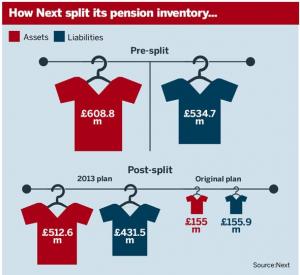Next splits pension fund in bid to turn buy-in to buyout
High-street retailer Next is planning to complete a partial buyout worth around £150m within three months, after completing an innovative split of its pension fund to hive off the lion’s share of its pensioner liabilities.
Market participants have said improved funding levels are making bulk annuity transfers more popular, with employers keen to remove pension funding volatility from their accounts.
Next Group Pension Plan completed successive buy-ins of its pensioner liabilities in 2010 and 2012, together amounting to almost a quarter (24 per cent) of the plan’s total pension liabilities.
The company is now looking to convert these buy-ins to a buyout, moving the liabilities off the balance sheet. To facilitate this, in 2013 a new plan was established for existing members whose pensions are not insured through the buy-in (see graphic).
The new plan now has £512.6m of assets, while £155m remains in the original plan.“It is intended that the pensions and matching insurance contracts held by the original plan will be converted to buyout, and the original plan can be dissolved,” said the retail group’s 2014 annual report.
A spokesperson for Next said the plan had to split “because [the company] legally had to do it to move from a buy-in to buyout” and that the split did not result in additional employer contributions or an increase in funding level.
The spokesperson added: “The buyout hasn’t been completed, but should be done in the next three months.”
The need to ensure all members are paid the same benefits can be seen as a hurdle for employers looking to convert a buy-in to a buyout, which means one tranche of benefits have been secured at a set level.
“The trouble is that in most cases the trustees find it difficult to shatter the buy-in policy and give each pensioner a policy, thereby discharging their obligation,” said Duncan Buchanan, partner at law firm Hogan Lovells.
“The reason being it is thought that the uninsured members, deferred members will be adversely affected.”
However the structure of creating a new plan is something employers are beginning to talk about due to the accounting benefits to the employer.
Dominic Grimley, principal at consultancy Aon Hewitt, said moving from a buy-in to a partial buyout can be difficult and may not be allowed under some scheme rules.
“That is why a sponsor will potentially purpose splitting the scheme,” he said. “Normally, the scheme which contains the new people, the pensioners, can be put into wind-up… so that the scheme’s rules may have been deliberately designed in way that was buy-out ready.”
Grimley said schemes that had put buyouts on the shelf due to the expense over the past couple of years, are now beginning to look at again as funding levels are on the rise.
“The liabilities are not as high as they were and it has been a good period of asset returns, so suddenly there are quite a lot more schemes where full buyout is affordable or it is close enough to start preparing for it,” he said.
Most Viewed
- What does Labour have in store for the pensions industry?
- LGPS latest: GLIL backers invest £475m for UK infrastructure push
- Dashboard costs rose by 23% in 2023, figures show
- Border to Coast launches UK strategy in major private markets push
- How the pensions industry can better support people with mental health problems


